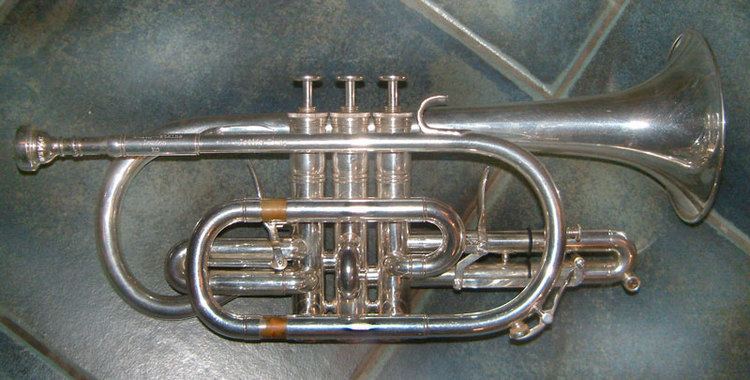 | ||
In music, the bore of a wind instrument (including woodwind and brass) is its interior chamber. This defines a flow path through which air travels, which is set into vibration to produce sounds. The shape of the bore has a strong influence on the instrument's timbre.
Contents
Bore shapes
The cone and the cylinder are the two idealized shapes used to describe the bores of wind instruments. These shapes affect the harmonics associated with the timbre of the instrument. The conical bore has a timbre composed of odd and even harmonics, while the closed cylindrical bore or closed tube is composed primarily of odd harmonics. The harmonic characteristics of instruments such as the clarinet (closed cylinder) are more variable than a given waveform and bore alone is not the only determining factor. The timbre of a clarinet, for instance, mainly depends on the construction of the mouthpiece and the properties of the reed. Furthermore, minute changes in air pressure and pressure applied to the reed (vibrato, slurs) modulate the tone.
Cylindrical bore
The diameter of a cylindrical bore remains constant along its length. The acoustic behavior depends on whether the instrument is stopped (closed at one end and open at the other), or open (at both ends). For an open pipe, the wavelength produced by the first normal mode (the fundamental note) is approximately twice the length of the pipe. The wavelength produced by the second normal mode is half that, that is, the length of the pipe, so its pitch is an octave higher; thus an open cylindrical bore instrument overblows at the octave. This corresponds to the second harmonic, and generally the harmonic spectrum of an open cylindrical bore instrument is strong in both even and odd harmonics. For a stopped pipe, the wavelength produced by the first normal mode is approximately four times the length of the pipe. The wavelength produced by the second normal mode is one third that, i.e. the 4/3 length of the pipe, so its pitch is a twelfth higher; a stopped cylindrical bore instrument overblows at the twelfth. This corresponds to the third harmonic; generally the harmonic spectrum of a stopped cylindrical bore instrument, particularly in its bottom register, is strong in the odd harmonics only.
Instruments having a cylindrical, or mostly cylindrical, bore include:
Conical bore
The diameter of a conical bore varies linearly with distance from the end of the instrument. A complete conical bore would begin at zero diameter—the cone's vertex. However, actual instrument bores approximate a frustum of a cone. The wavelength produced by the first normal mode is approximately twice the length of the cone measured from the vertex. The wavelength produced by the second normal mode is approximately equal to the length of the cone, so its pitch is an octave higher. Therefore, a conical bore instrument, like one with an open cylindrical bore, overblows at the octave and generally has a harmonic spectrum strong in both even and odd harmonics.
Instruments having a conical, or approximately conical, bore include:
Woodwinds
Sections of the bores of woodwind instruments deviate from a true cone or a cylinder. For example, although oboes and oboes d'amore are similarly pitched, they have differently shaped terminal bells. Accordingly, the voice of the oboe is described as "piercing" as compared to the more "full" voice of the oboe d'amore.
Although the bore shape of woodwind instruments generally determines their timbre, the instruments' exterior geometry typically has little effect on their voice. In addition, the exterior shape of woodwind instruments may not overtly match the shape of their bores. For example, while oboes and clarinets may outwardly appear similar, oboes have a conical bore while clarinets have a cylindrical bore.
The bore of a modern recorder has a "reversed" taper, being wider at the head and narrower at the foot of the instrument.
Brasses
Brass instruments also are sometimes categorized as conical or cylindrical, though most in fact have cylindrical sections between a conical section (the mouthpiece taper or leadpipe) and a non-conical, non-cylindrical flaring section (the bell). Benade gives the following typical proportions:
These proportions vary as valves or slides are operated; the above numbers are for instruments with the valves open or the slide fully in. Therefore the normal mode frequencies of brass instruments do not correspond to integer multiples of the first mode. However, players of brasses (in contrast to woodwinds) are able to "lip" notes up or down substantially, and to make use of certain privileged frequencies in addition to those of the normal modes, to obtain in-tune notes.
